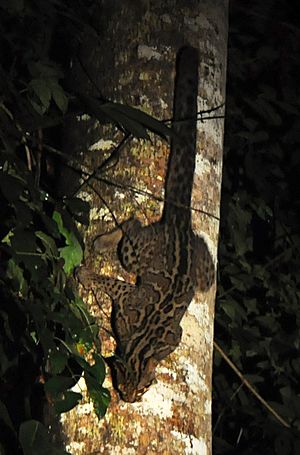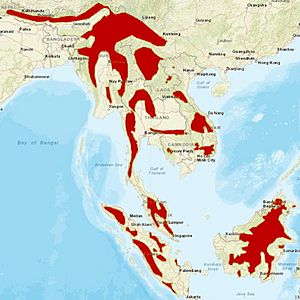Marbled cat facts for kids
Quick facts for kids Marbled cat |
|
|---|---|
 |
|
| A marbled cat in Danum Valley, Borneo | |
| Conservation status | |
| Scientific classification | |
| Genus: |
Pardofelis
|
| Species: |
marmorata
|
| Subspecies | |
|
|
 |
|
| Distribution of marbled cat, 2016 | |
The marbled cat (Pardofelis marmorata) is a small wild cat. It lives in forests from the eastern Himalayas to Southeast Asia. You can find it in high places, up to about 2,500 meters (8,200 feet) above sea level.
Because it lives across a wide area, it has been listed as "Near Threatened" since 2015. This means it's not in immediate danger. However, its population could become threatened if things don't improve. The marbled cat is a close relative of the Asian golden cat and the bay cat.
Contents
What Makes Marbled Cats Special?
The marbled cat is about the same size as a domestic cat. But it has rounded ears and a very long tail. Its tail can be as long as its head and body combined! This long tail helps it balance when climbing trees.
Appearance and Fur
Its fur is thick and soft. The color of its fur can be brownish-grey or a yellowish-brown on top. It's usually greyish or buff underneath.
The cat has black stripes on its small, round head, neck, and back. On its tail, legs, and belly, it has solid spots. On its sides, it has irregular dark patches that look like a "marbled" pattern. This is how it got its name!
Unique Features
Marbled cats have large feet. They also have unusually large canine teeth. These teeth look like those of much bigger cats, even though marbled cats are small.
Their paws have webbing between the toes. This might help them climb or move around in wet areas.
Size and Weight
Marbled cats are usually between 45 to 62 centimeters (18 to 24 inches) long from head to body. Their long, bushy tail is 35 to 55 centimeters (14 to 22 inches) long.
They typically weigh between 2 and 5 kilograms (4.4 and 11 pounds).
Where Marbled Cats Live
Marbled cats live in the foothills of the eastern Himalaya mountains. They are also found in tropical Indomalaya, stretching eastward into southwest China. You can also find them on the islands of Sumatra and Borneo.
Preferred Habitats
These cats mostly live in moist and mixed deciduous-evergreen tropical forests. In India, they are found only in the north-eastern forests.
Recent Sightings
- In eastern Nepal, a marbled cat was seen for the first time in January 2018. It was outside a protected area at an altitude of 2,750 meters (9,020 feet).
- In northeast India, they have been recorded in several wildlife sanctuaries and reserves. These include Eaglenest Wildlife Sanctuary and Dampa Tiger Reserve.
- In Bhutan, they live in Royal Manas National Park and other forests up to 3,810 meters (12,500 feet) high.
- In Thailand, one was seen in a hill evergreen bamboo mixed forest.
- In Borneo, they have also been found in peat swamp forests.
Population Size
Scientists don't know exactly how many marbled cats there are. They are hard to find. In some parts of Sabah, Borneo, estimates suggest there might be 7 to 20 cats per 100 square kilometers (39 square miles).
Marbled Cat Behavior and Life
Marbled cats recorded in northeast India and Kalimantan on Borneo were active during the day. However, the first marbled cat tracked with a radio collar was mostly active at night and during twilight (dawn and dusk).
What They Eat
Marbled cats likely find most of their food in the forest canopy. They eat birds, squirrels, other rodents, and reptiles.
One marbled cat in Thailand was seen hunting a Phayre's leaf monkey.
Reproduction and Kittens
A few marbled cats have been born in zoos. Pregnancy lasts about 66 to 82 days. Usually, two kittens are born in each litter.
Newborn kittens weigh about 61 to 85 grams (2.2 to 3 ounces). Their eyes open around 12 days old. They start eating solid food and climbing actively when they are about two months old.
Marbled cats become adults at 21 or 22 months of age. In zoos, they have lived for up to 12 years.
Threats to Marbled Cats
The biggest danger to marbled cats is the loss of their forest homes. They need large areas of healthy forest to survive.
Habitat Loss
Forests are being cut down across their range. This happens because of logging, new human settlements, and farming.
Other Dangers
Snaring (trapping animals with wire loops) is common where they live. This is also a major threat.
Marbled cats are sometimes hunted for their skin, meat, and bones. However, they are not often seen in the illegal Asian wildlife trade.
In one area of Arunachal Pradesh, India, a marbled cat was killed by a local hunter. It was used in a ceremony for a festival. Its blood was offered to a deity for good luck and a good harvest.
Protecting Marbled Cats
The marbled cat (Pardofelis marmorata) is listed in CITES Appendix I. This means it is highly protected internationally. Many countries also protect it.
Hunting Laws
Hunting marbled cats is against the law in many places. These include Bangladesh, Cambodia, Yunnan (China), India, Indonesia, Malaysia, Myanmar, Nepal, and Thailand.
In Laos and Singapore, hunting is regulated, meaning there are rules about it. In Bhutan and Brunei, the marbled cat is not legally protected outside special protected areas.
Marbled Cat Family Tree
The scientific name for the marbled cat, Felis marmorata, was first used in 1836. It was given by William Charles Linnaeus Martin.
Today, scientists recognize two main types, or subspecies, of marbled cats:
- P. marmorata marmorata: Found from the Malay Peninsula to Sumatra and Borneo.
- P. marmorata longicaudata: Found from Nepal to north of the Isthmus of Kra.
How They Relate to Other Cats
Scientists used to think the marbled cat was related to the "big cats" like lions and tigers. But studies of their DNA show something different.
The marbled cat is actually part of a group with the Asian golden cat and the bay cat. This group of cats separated from other cat families a very long time ago. The marbled cat then branched off from this specific group about 8.4 to 4.2 million years ago.
See also
 In Spanish: Gato jaspeado para niños
In Spanish: Gato jaspeado para niños


